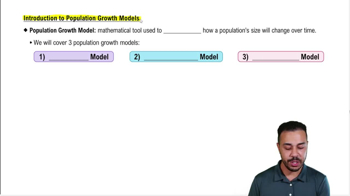Here are the essential concepts you must grasp in order to answer the question correctly.
Induced Fit Model
The induced fit model describes how enzymes and substrates interact. Unlike the lock-and-key model, which suggests a perfect fit, the induced fit model posits that the enzyme's active site undergoes a conformational change upon substrate binding. This flexibility enhances the enzyme's ability to catalyze reactions, as the active site molds itself around the substrate, improving the fit and facilitating the chemical reaction.
Recommended video:
Introduction to Population Growth Models
Enzyme-Substrate Interaction
Enzymes are biological catalysts that speed up chemical reactions by lowering the activation energy. The interaction between an enzyme and its substrate is crucial for catalysis. The substrate binds to the enzyme's active site, and the induced fit model illustrates how this binding can alter the enzyme's shape, optimizing the reaction process and increasing efficiency.
Recommended video:
Conformational Change
Conformational change refers to the alteration in the shape of a protein, such as an enzyme, in response to binding with another molecule, like a substrate. This change is essential for the function of many proteins, as it can activate or deactivate their activity. In the context of the induced fit model, the conformational change allows the enzyme to better accommodate the substrate, leading to a more effective catalytic process.
Recommended video:
Pollution and Climate Change
 Verified step by step guidance
Verified step by step guidance


